The Impact of Construction Delays
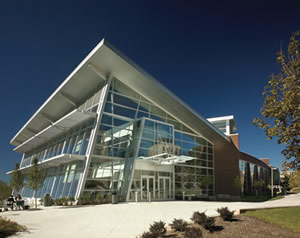
PHOTOS COURTESY OF THE RUHLIN COMPANY
When a college campus undertakes construction projects, time is money. Construction programs can involve expensive equipment, significant overhead, substantial manpower and timely demands on both the contractor and the university. When unexpected events delay construction progress, these costs can escalate, impacting more than just the budget.
While a two-week delay may be manageable on other jobsites, a small delay on a college or university campus might spark a four-month setback. Academic institutions often measure time in semesters rather than days or weeks; if a project drags past the start of a semester, many colleges are reluctant to relocate classes until the start of the following semester.
The key to building successful higher education facilities is staying on schedule — which requires identifying potential setbacks, carefully planning to avoid risks and proactively preparing for what-ifs to minimize the high cost of construction delays.
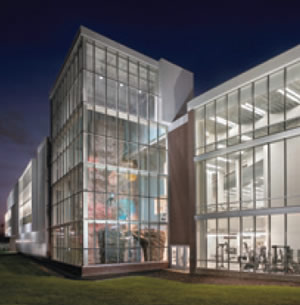
PHOTOS COURTESY OF THE RUHLIN COMPANY
What’s the plan? Keep an eye on what your staff is doing that might cause delays. Typical examples include being unprepared for the start of construction, submitting approval of drawings late or making last-minute change requests to plans. Where your team is at fault, you may need to absorb the costs and work around the delays to keep the rest of your campus operations on schedule. When you work closely with your construction contractors, people will more readily cooperate when problems arise that are not your fault.
THE CAUSE OF DELAYS
Countless events, both preventable and uncontrollable, can delay construction on a jobsite, ranging from late delivery of materials to equipment issues, plan errors, change orders, site conditions and weather.
Even before breaking ground, funding and budgeting delays can push back project kick-offs, often derailing the whole job. Funding uncertainties, in particular, cause more construction delays in higher education than anything else. For example, The Ruhlin Company, an Ohio-based general contracting and construction management firm, saw one law school project delayed nearly seven years by funding issues. When construction finally starts next year, it will be at least 15 percent more expensive than anticipated because of price increases.
Due to the number of large buildings typically on campus, universities tend to have more construction projects lined up or occurring simultaneously than commercial or industrial complexes. It’s not uncommon for universities to undergo five or 10 projects at once as part of an overall building program, so they are especially susceptible to the domino effect. When one project’s kickoff is contingent upon the completion and occupancy of another, any delay can cause ripples, impacting budgets and available resources for other projects down the line.
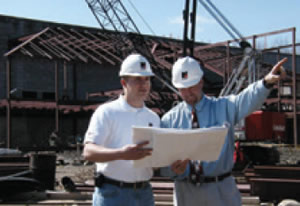
PHOTOS COURTESY OF THE RUHLIN COMPANY
Any time budgets shift or fall out-of-date, it adds extra time and fees for additional value engineering and, potentially, a total redesign.
PLAN FOR DELAYS
With so many moving pieces involved in construction, a well-planned schedule is critical for planning and sequencing work, coordinating resources and drafting recovery plans to prepare for the unexpected.
During the preconstruction planning phase, there is no substitute for experience. The key is to understand the project requirements and predict challenges — whether it’s long lead-time materials, or steel that’s only fabricated at certain times of the year. Universities are very knowledgeable about their own building requirements and standards, but they can tap into a wealth of knowledge by selecting a construction team with relevant higher education building experience.
Because both sides have value to contribute, establishing cooperative teamwork and transparent communication is key. Clear, open, honest communication is the best way to craft a plan to evade construction delays. Let’s be frank: construction projects rarely stay perfectly on schedule or go exactly as planned. No matter how carefully the schedule is developed, certain issues can’t be uncovered until the minute you knock down a wall.
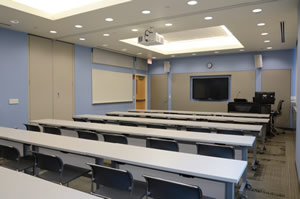
PHOTOS COURTESY OF THE RUHLIN COMPANY
Check the calendar. Then check it again. Projects fail to meet their scheduled goals because initial planning did not include establishing a realistic, achievable schedule. Don’t be hasty in announcing completion dates for projects before major design decisions are made and without the benefit of a meaningful, well-developed schedule. In the early stages, the plan should include preconstruction activities (e.g., land and right-of-way acquisition as required; environmental planning and approval; permitting, design, bid and award). Clearly communicate expected schedules, but remain flexible to anticipated delays.
Ruhlin can’t perform destructive testing on those law buildings ahead of time, for example, because they will house students up until construction begins. So you plan the best you can, build in some safety factors for the riskiest parts of the project, and have a solid backup strategy and a team of problem-solvers ready to jump in when things don’t go as expected.
WHEN THINGS GO WRONG
When problems arise on a construction project, the first step is determining the cause and effect of the delay. The best solution is not always as straightforward as insisting that the group who caused the issue be the one to solve it. Instead, it’s best to review with the entire project team, with the goal of finding the best solution for the overall project — not one particular party.
Usually the recovery plan includes several options to keep a project on track after delays. These could include working overtime to catch up or rearranging the sequence of work to maintain productivity around obstacles. Over the last few years, for example, we worked on the campus of an Ohio-based medical university, where we constructed a new addition to an existing building. We had to stay away from the tie-in point at certain times because students were taking finals, so we identified other areas where we could be productive during those exam periods.
To reduce recovery costs, we try to gain the most calendar days with the fewest man-hours, by applying overtime to the smallest crews possible. For example, enclosing a building usually involves a smaller crew of masons or ironworkers than the finishing work; it’s much more expensive to pay overtime for finishing work than to pay overtime to get the building enclosed so the finishing crews can stay on schedule.
Sometimes, delays demand more creative workarounds. For example, Ruhlin recently built a facility with a completion date in February — which meant that paving had to be completed before the asphalt plants closed for winter. But because of extensive rain that summer and fall, the soils were too soft to support the weight of the pavement. To solve the problem, we added Portland cement to firm up the soil instead of waiting for it to dry and pushing back the completion date.
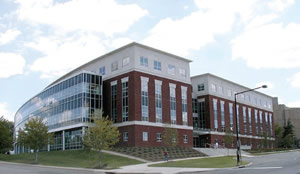
PHOTOS COURTESY OF THE RUHLIN COMPANY
Keep them in the loop. Students, staff and faculty are impacted daily by construction on your campus, and any delays in the projects as well. Consider the benefits of keeping everyone on campus informed of changing schedules, perhaps using a web page or via an electronic mailing list that distributes notification of road closures, construction delays or other unusual events surrounding changes in the schedule of the completion of an eagerly anticipated new or renovated facility.
The logistics of getting a project back on track comprise only one piece of the puzzle, though. The biggest side effect is the lack of trust that can creep into a project, causing finger pointing and faultfinding that can damage team morale. Maintaining good rapport between owner, architect and contractor is just like maintaining any personal relationship: Admit mistakes, be open about problems, and stay focused on finding solutions instead of placing blame.
Most people understand that mistakes happen and that the best-laid plans often go awry. If everyone is upfront about addressing the issue, you can manage the impact much better than reverting to claims and litigation.
WHO PAYS FOR DELAYS?
Everyone pays something for construction delays: either through direct costs, as money is spent to resolve issues, or through indirect costs, as time and resources are diverted away from other pursuits. At a minimum, there will be additional supervision and involvement from all parties just to figure out how to work around a delay — which may cause late occupancy, class scheduling issues and other headaches.
In my college construction management classes, we learned about the Eichleay formula, which is a relatively long, complicated method of determining indirect costs associated with delays. The first time I worked on a real project with a sizable delay, I quickly realized that calculating the true cost is not so clear-cut. Every day and dollar that a project eats up has to come from somewhere, so delays can impact entire building programs around campus.
Everyone involved in a higher education building program has a vested interest in keeping projects on time and on budget. While every party has its goals and priorities, the only way to reduce the high cost of construction delays is for everyone to work together with the common goal of keeping projects progressing on schedule.
This article originally appeared in the issue of .